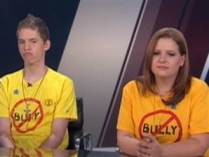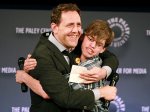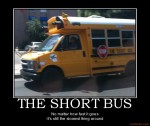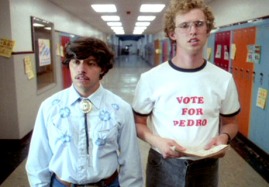
Jackie Libby recalls that she and her husband, once found their son Alex passed out in the front yard of their Sioux City home.
“He said some boys were slamming his head into a seat on the bus,” Jackie said. “We thought he made it up.”
I keep seeing commercials for The Bully Project. So I’m starting to pay attention. I watched an interview with Alex Libby, one of the 5 kids who were followed for a year in this important documentary. The stories of these kids are heart-breaking, and include two children who committed suicide after prolonged bullying.
Something about Alex made me watch more carefully — does he have some form of autism? They don’t mention it – but I spot a blue puzzle pin near his shoulder, and when I look closely his mom is wearing one too. I check the promotional website but Alex’s bio doesn’t mention Autism. I wonder why.

Alex Libby and his mom Jackie during a TV interview about the movie release http://thebullyproject.com/indexflash.html
Digging deeper, I find an explanation from the film-maker, Lee Hirsch: “…both Tyler Long and Alex have Asperger’s Syndrome, and we made a conscious decision not to disclose that in the film. We certainly could have, and perhaps it would have been insightful to the audience and we talked about it a lot. Ultimately, we decided that we didn’t want anything to make the audience think, Oh, well, that explains it. Well, of course. We didn’t want anything that anyone could hang onto in that way.”
Wow. That explains it? Well of course? Like, they have Asperger’s syndrome, so of course they’re going to be bullied?
A variety of kids are targeted by bullies, not just kids with autism. Gay kids are beaten up. Kids with learning disabilities and mental health diagnoses are called names. Kids who are perceived as weak and non-assertive are intimidated. Kids who are different are at risk of being bullied in so many different ways. But somehow, Alex’s blue puzzle pin reminds me of Katniss’ mockingjay pin in the Hunger Games books: a signal of solidarity from Alex and his mom to those of us affected by autism. A tiny symbol of rebellion from Alex in the middle of a media circus.

Rachel is slushied on Glee, a TV show that uses music and humor to discuss important social issues affecting teens
When people complain that the definition of Autism is “widening” and about “over diagnosis”, I hear them questioning whether kids similar to Alex should be included in the Autism numbers. People may argue that the articulate and aware Alex doesn’t “really” have autism, and that he was just another “different” kid who got beat up on the bus. In my life, I’ve met so many kids like Alex; kids with high functioning Autism who can manage at school without behavior problems, kids who can do the schoolwork, but just don’t fit in. Kids who have been shuttled for years to different doctors by anxious parents, without a diagnosis or treatment. Kids whose parents, like Alex’s, have more than a little bit of denial about the cruelty of other kids. Many kids with Asperger’s get diagnosed as late as 6th or even 9th grades, and already have significant depression and anxiety. These kids don’t need one -on -one assistance at school, and many of them would be mortified to have someone hovering near them all day. But they are at risk from aggressive kids, and need vigilant adults who are willing to intervene. [ Autism Puts Children At Risk for Bullying]
Worry about out-of-control kids underlies decisions parents make about schools for their mainstreamed kids with autism. As teenagers move through middle school to high school, supervision and monitoring is looser, and possibilities of victimization increase. Often, parents find alternative solutions, and send vulnerable kids to smaller religious- based schools and charter schools. Many parents don’t take any risks at all and pull out of the game, cyber-schooling at home. They don’t trust that adults within schools will do what is necessary to keep vulnerable kids safe.
Maybe you think Alex should have been riding on the short bus, where he would have been safe from bullying peers. Maybe you think he should have been home schooled. But shouldn’t Alex be accepted for who he is, and have the independence he has earned? When kids with autism gain independence, parents worry less about their own child’s behavior, and instead focus on their safety.
Kids like Alex may no longer be diagnosed with autism with the stricter criteria developed for the upcoming revision of the Diagnostic and Statistical Manual. The DSM is the document developed by psychiatrists outlining consistent criteria for diagnosis of mental disorders. Since insurance companies are starting to be forced to cover autism, I wonder about their role in tightening up the diagnostic criteria. The new CDC autism numbers, showing that 1 of 88 kids have autism, may still be just the tip of the iceberg, as a study by a Yale researcher found autism rates in South Korea are 1 in 38. 1 in 38 could cost a lot of money.
There will always be kids who don’t fit in. Who don’t wear the right clothes. Who are preoccupied with Pokemon and Star Wars, and who’ve never heard of One Direction or Big Time Rush. Kids who are unaware of the subtle pecking order of kids, and who don’t know the rules of where to sit at lunch or on the bus. Kids who get teased. Kids who don’t get the rules of the playground games, and who melt down when they lose. Kids who nobody likes. Where is the dividing line between the annoying kid, pestering everyone with repeated questions, and the kid with a clinical diagnosis? Which kid deserves insurance reimbursed therapy, and which should be left on his own, to sink or swim?
At this point you may be wondering whether the kids who are bullied are really the ones who need to be changed. It’s a good question. Should kids have to change who they are? Well, no, we should not try to change gay kids, or keep them in the closet. Diversity makes people interesting. But we do need to look at the bullying ringleaders, whose unbridled aggression may develop into long-term anti-social behavior. This is quite different from many kids with autism, who desperately want friends, but just don’t know what they are doing wrong.
Alex Libby, talking about the kids on the bus: “If you say these people aren’t my friends, then what friends do I have?”
We want our kids with autism to actually have friends. We want people to like them; we want them to be be included. In social groups, I don’t use behaviorism to coerce kids to bounce their balls in the same rhythm. And I’m not looking to transform kids with autism into Popular Kids. But I do want kids with autism to ride the school bus with the other kids without getting beaten up. Maybe if I do a good job they will just….pass. Maybe if I teach the right skills, when students are partnered with a child with autism, the other kids won’t roll their eyes or wince, making sidelong glances and exchanging smirks of sympathy. Or maybe typical kids will invite friends with autism to birthday parties because they want to, not because their mom said they must. I try to teach kids skills that will help them survive out there in the real world, such as what clothes and music are in, how to know when someone isn’t interested in what you’re saying, how to be flexible with rules, perspective-taking, and how to tolerate feedback without crying. I set things up so they can experience the enjoyment of having fun with other kids, and so they will have the motivation to keep trying. But teaching social skills costs money. Health care dollars.
As parents, we want our kids to be accepted and have a couple of friends. We don’t want them to go trick or treating with us when they are 16, or to be alone on their birthdays. We don’t want them to tolerate cruelty as the only attention they get, and we surely don’t want them to contemplate suicide. We have to work through our own pain to face the difficult issues: we have to face the pain of seeing our beloved sons and daughters rejected by strangers, and the pain of our own experiences of being left out and getting picked on. We have to find our voices and speak up, and then we can teach our children to stand up for themselves.
I love hearing your comments and thoughts! You can comment on the blog, on Facebook, or send me your thoughts by e-mail at trebat@ptd.net
Share this post by e-mailing the link on the button below, or by sharing or commenting on Facebook.








